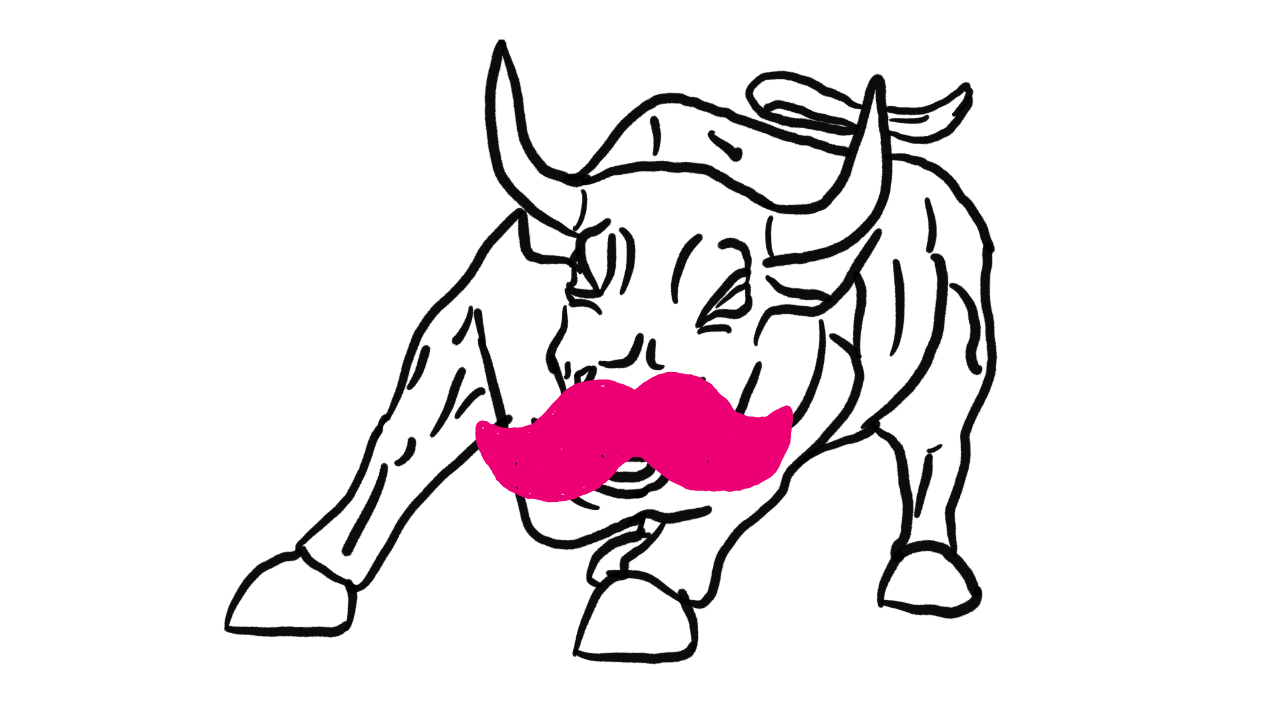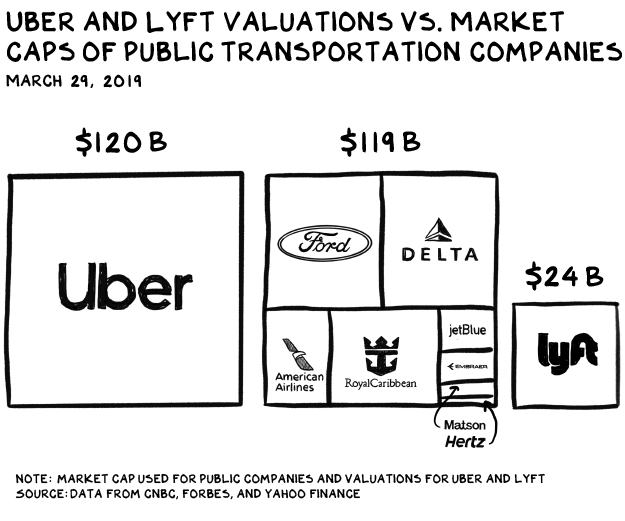
LYFT-Off?
Lyft is now trading on the NASDAQ exchange, and I predict it will break $100/share, 40% above the $70-72 price range set by bankers. Twelve months later, the shares will trade much, much lower. Note: Predicting is dangerous work, so if I’m wrong, I’d ask that you love me, not judge me. But I digress.

Lyft’s prospectus sounds like a CFO grabbed the mic at an AOC fundraiser — littered with terms like “social impact” and “carbon offsets.” This is a bit of an illusionist’s trick, as Lyft’s admirable focus on the environment wallpapers over the real emissions of ride hailing: a transfer of wealth from drivers to riders. The “gig economy” is Latin for an erosion in minimum wage protection or the notion that firms should provide benefits to workers. The payoff, according to these firms, and the drivers, is worker flexibility. However, as someone who’s hired hundreds of employees and contractors, the notion that a firm cannot provide flexibility and insurance to employees is simply not true. However, compliance with labor laws sucks, as it’s expensive. Like all of big tech, expensive (non-scaleable) translates to “impossible” for these firms.
The “gig” economy (what a cute word) has been more fuel for a dynamic that’s hollowing out the middle class. Employment has never been stronger — all you need is a smartphone and a car, and you’ve got a job. But wages have been flat for 30 years. Prosperity without progress is a decent description of our economy the last decade(s). The ninja move kicking the middle class in the nuts is best typified by ride-hailing firms. Uber commands a $120 billion valuation, meaning the firm garners the same value as:
American Airlines
Delta
Ford
Hertz
Embraer
JetBlue
Matson, and
Royal Caribbean
…COMBINED.

Armed with the Praetor, I will be at SXSW, and over dinner I’ll casually offer Anand Giridharadas and Kara Swisher a ride back to NYC … on my Praetor. At that exact moment, I become almost good looking and 100% fascinating. On the ride back, we drink … a lot. Kara doesn’t drink, but she drinks on my Praetor 500. I aspire for both of them to like, even love me, as they are uber-interesting and have great hair — hugely important. After admiring the curvature of the Earth, in my Praetor, we come up with nicknames for Anand (Nando, A-Nando-Mous) and ask Kara questions about lesbian sex (I have a lot of questions). Note: the last sentence is likely several hate crimes on several levels. But I digress.

Value
When retail investors stampede through the door marked “disruptor” on the first day of trading (“disrupt” was mentioned 10 times in Lyft’s prospectus), the market value could hit 10-15 times 2018 revenues. In 2018, Lyft clocked $2.2 billion in revenues and lost $911 million. That means if you pay $12 for a ride in a car with a pink moustache, it cost the firm $17. So, it’s economically irresponsible not to take Lyft (or Uber) everywhere.
Firms that trade at over 10 times revenues have several things in common:
— Explosive growth
— Recurring revenue
— Network effects
Lyft has the first (2018 revenue doubled YOY), but doors 2 and 3 are the stuff of Amazon, Netflix, Facebook, Microsoft, and WeChat. Despite using the term “network effect” 7 times in the prospectus, there is no network effect here. There admittedly could be scale, but not the Instagram-like network effect where every person who joins is likely to bring their friends with them and will interact with a lot of other users. My taking a Lyft tonight creates scale, but no flywheel effect similar to when I search for where to eat. Searching and clicking on Google informs the algorithm, making the next search one three-billionth better for the next person using Google.
Lyft should, and will, be valued at a multiple of EBITDA (vs. revenues) soon. Their scale can/may get them to profitability. But their charade around network effects will result in a different valuation construct that, like every other great transportation firm, will value them at 6-12x EBITDA (maybe $35/share in 5 years if they execute well). Maybe.
Tech’s Real Talent
As the founders of Lyft pretend they are saving the planet while accidentally becoming billionaires, the roadshow/sermon is forced to relocate from SF to another city, as the entrance is blocked by protestors representing 98% of the firm’s workforce. The real talent that’s evolved over the last decade in the tech community is not mastery of technology, business models, or building cultures of creativity. Instead, tech’s genius is fostering the unfettered belief that they are “making the world a better place.”
When you get in the back of a car with an internal combustion engine, driven by one of 1.4 million drivers getting a dime as their share of the $20-30 billion value they’ve helped create, who don’t have health insurance or minimum wage protection, you can palliate your conscience, as the firm has purchased carbon offsets.
“Taxi!”
Life is so rich,

P.S. I’ve written a new book, The Algebra of Happiness: Notes on the Pursuit of Success, Love, and Meaning, out May 14 from Penguin Portfolio. Preorder now and I will surround you with white light.
14 Comments
Need more Scott in your life?
The Prof G Markets Pod now has a newsletter edition. Sign up here to receive it every Monday. What a thrill.


Great article as always ! I`m going to short all the IPO this year except a few and Lyft will no be one of them. This is 1999 party once again with different audience but the same investment helpers (Uber at $120Bn yes, sure). One idea for Uber.. buy Tesla at $25Bn (coming soon) and lease the cars to drivers .. in a nextflix like subscription model…every one win :), and you can keep your subscription like valuation (for a couple of years more) !
Scott, preorder on AMAZON? can we find another nonmonopolistic way?
Professor Scott,I am a great fan of your work. However, in my opinion, your point about Lyft not having network effects is conceptually wrong. By definition, network effects are the incremental benefit gained by an existing user for each new user that joins the network. This clearly happens in the case of Lyft.Lyft and Uber are platforms (two user groups: drivers and riders) and Instagram is a network (one user group, not a platform).Lyft and Uber clearly have network effects: as more riders join the platform, the more useful and valuable it is to drivers, and vice-versa. This is called indirect network effects because the value of the service increases for one user group when a new user of a different user group joins the network.The relevant discussion is the strength of such network effects, how much replicable they are by a new entrant. But the argument that Lyft has no network effects is simply flawed.
Does Google really have that much network effects? It’s pretty easy to use Duck and they push fewer ads on you.It seems to me that the only thing keeping Google on top is the quality of their results. Others are catching up.Duck’s growth for the past decade is a fairly tightly fitted exponential curve.
Duckduckgo is using googles algo….
Viewing Google as just a search engine is too narrow. It is better to view it as an elaborate ecosystem. The search engine, Youtube, Chrome browser, Android, Waymo, Kaggle, Tensorflow, Kubernetes and, other popular open source projects are just some examples. With Youtube and Kaggle, the network effects are pretty clear as they are social platforms. Tensorflow is the most used machine learning framework today. There is a whole world of other frameworks and tools built on top of TF. If you are a serious ML professional, you need to know TF. And to work on interesting projects, more data scientists learn TF and recommend it to others. This means a lot of cutting edge AI tech is increasing TF dependent. Hence the network effects.In case of Chrome, Chromium the open source project that powers Chrome is similarly being adopted by all major browsers. So much so that it is at the risk of monopolizing browsers, which is worrying a lot of web experts.
Great article
White light back to you. You made my day. Now jumping into..Paris subway.
This is yet another example of the self-deceiving way in which authority can present domination as altruism. See Uber and Amazon for even more egregious examples. In “One Flew Over The Cukkoo’s Nest” Nurse Ratched sincerely believes that what she is right. The author, Kesey, refers to it “bullshit consciousness”. Or Milo Minderbinder in “Catch 22” and what’s good for M&M is good for the country. He also gives out “shares”, sometimes replacing medicines in a war with “shares”. And like Lyft he is completely unaware of himself, his action and thoughts. In this respect, Lyft shows life imitating art in a tragic way.
Of course I meant to say about Nurse Ratched that she believes that what she is doing is right. (Sorry about that!)
Scott, I loved your first book. So I am going to buy the second one too. Would you recommend buying an audio version (my preference since I listen to them during my commute), or does it have too many visuals that I will miss out on?
Lyft is so rich
It’s just very sad. What’s your prediction – war, famine, revolution, more of the same?
Great post on LyftI preordered your bookBut white light did not surround meMaybe Life ISN’T RichPeace